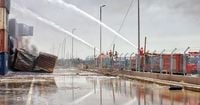The death toll from a massive explosion at Shahid Rajaei port in Bandar Abbas, Iran, has risen to at least 65, with over 1,000 others injured, according to state media reports on April 28, 2025. The blast, which occurred on April 26, 2025, has sent shockwaves throughout the region, raising serious concerns about safety protocols in one of Iran's most vital commercial hubs.
The explosion took place at a time when Iranian and U.S. officials were engaged in delicate negotiations regarding Iran's nuclear program in Oman. As discussions progressed, the incident has drawn attention to the ongoing tensions between Iran and Israel, with speculation about potential sabotage lingering in the air.
Iran's Supreme Leader, Ayatollah Ali Khamenei, has called for a thorough investigation into the incident, urging security and judicial officials to uncover any negligence or intent related to the explosion. "Security and judicial officials are obliged to thoroughly investigate, uncover any negligence or intent, and follow up in accordance with regulations," Khamenei stated, as reported by state television.
Initial assessments suggest that the explosion may have originated from a depot storing hazardous chemical materials. The port's customs office indicated that a fire likely broke out at this location, leading to the catastrophic blast. Interior Minister Eskandar Momeni confirmed that "culprits have been identified and summoned," attributing the explosion to shortcomings in safety precautions and negligence.
The exact cause of the explosion remains unclear. A report from The New York Times cited sources connected to Iran’s Islamic Revolutionary Guard Corps, suggesting that sodium perchlorate—a chemical used in solid missile fuel—was likely involved. However, Defense Ministry spokesman Reza Talaei-Nik denied the presence of any imported or exported military fuel at the site.
Despite the Iranian military's denial of receiving a recent shipment of missile fuel, private security firm Ambrey reported that the port had received ammonium perchlorate from China in March 2025. This shipment was intended to replenish Iran's missile stocks, which had been depleted due to its direct attacks on Israel during the ongoing conflict with Hamas in Gaza.
Eyewitness accounts and social media footage captured the chaos during and after the explosion, showing reddish-hued smoke rising before the detonation, reminiscent of the catastrophic Beirut port explosion in 2020. The blast shattered windows for several kilometers, tore metal strips off shipping containers, and caused extensive damage to goods within the port.
In the aftermath, Iranian President Masoud Pezeshkian visited hospitals treating the injured, expressing gratitude to first responders and pledging government support for the families affected by the tragedy. "We will try to take care of the families who lost their loved ones, and we will definitely take care of the dear people who got injured," Pezeshkian said.
As firefighting efforts continued, authorities declared a national day of mourning on April 28, 2025, following three days of mourning that began on April 27 in Hormozgan province. Schools and offices in the area were closed, and residents were advised to avoid going outside until further notice due to rising air pollution from the ongoing fires.
Iran's national oil company confirmed that the blast was unrelated to oil refineries, tanks, or pipelines. However, the incident has reignited discussions about safety standards at the port, which handles around 70 million tons of cargo annually and is a critical hub for Iran's trade, particularly through the strategic Strait of Hormuz.
In light of the explosion, experts have pointed to the potential dangers of poor storage practices for hazardous materials. Andrea Sella, a chemistry professor at University College London, explained that improper storage of substances like ammonium nitrate can significantly heighten the risk of explosions, particularly during a fire. "Material ignites and burns fiercely, followed seconds later by a devastating detonation, sending a supersonic shockwave that can shatter windows," Sella noted.
As investigations proceed, Iranian authorities are facing scrutiny over the safety measures in place at the port. The incident has raised alarms not just about local safety but also about the broader implications for regional stability amid ongoing geopolitical tensions.
With the world watching closely, the Iranian government is under pressure to provide answers and accountability following this tragic event. The Shahid Rajaei port, crucial for Iran's economy, must now grapple with the aftermath of this disaster while continuing to navigate complex international negotiations.
This explosion serves as a stark reminder of the vulnerabilities present in critical infrastructure and the potential consequences of negligence in safety protocols. As the nation mourns the loss of life, the focus will undoubtedly shift to ensuring such a tragedy does not occur again in the future.






